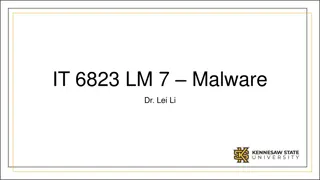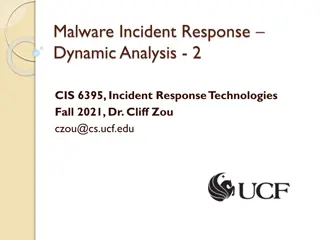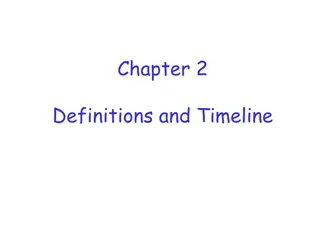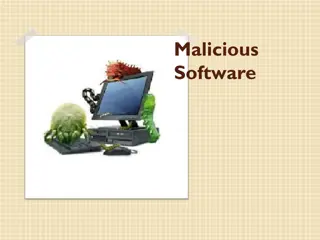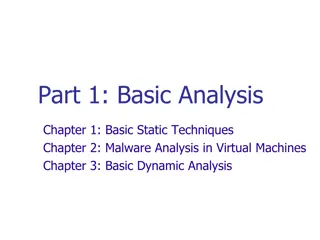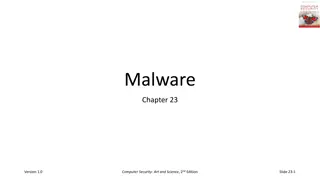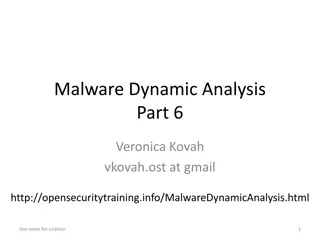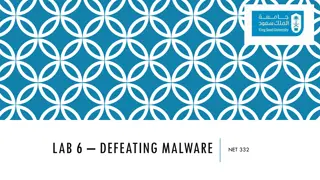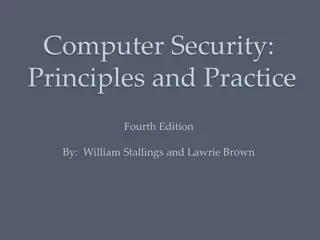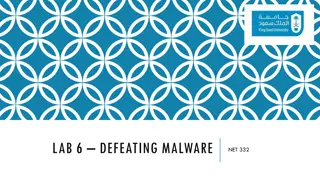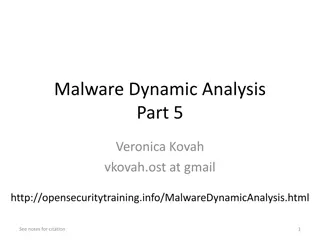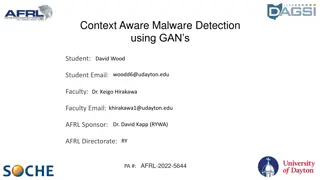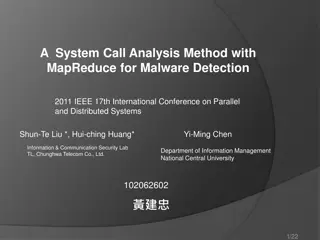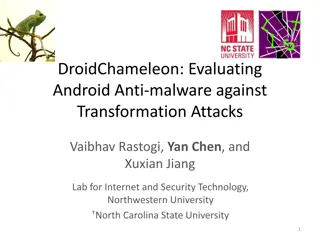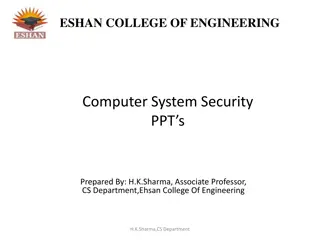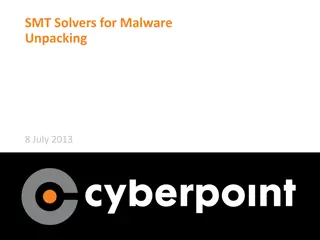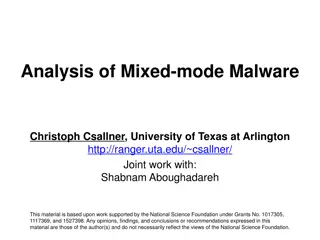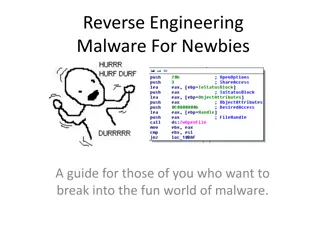Understanding Malware Execution and DLLs in IDA
Exploring how malware executes in IDA Pro, the significance of control flow graphs, DLL review, methods of utilizing DLLs for malicious activities, analyzing DLLs for code execution, and the management of processes in a secure environment. Gain insights into malware behaviors involving DLLs and process creation.
Download Presentation

Please find below an Image/Link to download the presentation.
The content on the website is provided AS IS for your information and personal use only. It may not be sold, licensed, or shared on other websites without obtaining consent from the author. Download presentation by click this link. If you encounter any issues during the download, it is possible that the publisher has removed the file from their server.
E N D
Presentation Transcript
Following Malware Execution IDA Pro s control flow graphs are very useful for viewing the malware s possible execution paths Function calls, loops, if statements, etc But malware can transfer execution in ways other than jumps and calls Often need to find out how the malware is executing other code 2
DLLs 3 3
DLL review Dynamic link library Exports functions for other executables to use Advantage: can be shared among running processes, saving memory Any disadvantages? 4
How Malware Uses DLLs By storing malicious code May export functions to other malware files May be loaded into another process By using Windows DLLs To interact with the operating system via Windows API functions By using third-party DLLs To interact with other non-Windows programs To use a library that may not be on the victim s machine 5
Analyzing DLLs DLLs have many points from which code can be executed from Each exported function DllMain which is not called explicitly, but rather DllMain is called whenever a process loads or unloads the DLL Normally used for managing any resources specific to a process, but malware sometimes uses it for other purposes 6
Processes 7 7
Process Review Process program in execution Used to keep programs from interfering with each other Have separate address spaces OS manages how processes access shared resources (CPU, filesystem, hardware, etc) 8
Creating a Process The CreateProcess function is typically used to create a process Has many parameters, gives caller a high amount of control over how the process is created 9
Running an Embedded Executable Suppose the Malware contains an executable as a resource Uses FindResource, LoadResource, CreateFile, etc to write resource to disk Uses CreateProcess to run the resource 10
Creating a Remote Shell Remote shell allows an attacker to run commands on the victim s computer remotely Can create a remote shell by opening a socket to the attacker s machine, and then making a single call to CreateProcess! 11
Creating a Remote Shell Need to pass specific arguments to CreateProcess The lpStartupInfo parameter points to a STARTUPINFO struct This struct contains handles to stdin, stdout, and stderr Point stdin, stdout, and stderr to the socket Call CreateProcess All input from the malware actor over the socket is run on the command line 12
Creating a Remote Shell Sample Code Practical Malware Analysis pg 148 13
Process Injection Malware can inject its own code into a different process Typically performed using the VirtualAlloc, WriteProcessMemory, and CreateRemoteThread API calls Will cover this and other covert launching techniques later 14
Threads 15 15
Thread Review Thread sequence of instructions belonging to a process that is executed by the CPU Each process contains one or more threads All threads share the process memory space Each thread has its own registers and stack 16
Creating a Thread Done using the CreateThread function Takes lpStartAddress, a pointer to a function Also takes lpParameter, a single parameter to the function The thread executes the function until it returns 17
Covertly Loading a Malicious Library Can use CreateThread to covertly load a malicious library into a process Need to set certain parameters to CreateThread Pass the address of the LoadLibrary Windows API function as the lpStartAddress parameter Pass the name of the desired library as lpParameter Even more stealthy if LoadLibrary and the name of the library are obfuscated 18
Services 19 19
Services Review Service a task that runs in the background without an associated process or thread Managed by the Windows service manager The command net start can tell you what services are running 20
Why Malware Uses Services Can be set to automatically run when the computer boots Gives persistence Often run with SYSTEM privileges But need admin to specify this 21
Creating / Starting a Service OpenSCManager Returns a handle to the service control manager, which is needed for all other service-related API calls CreateService Adds a new service to the service control manager Can specify that the service automatically runs at boot StartService Starts a service manually 22
Types of Services WIN32_SHARE_PROCESS Stores code for a service in a DLL, run by svchost.exe WIN32_OWN_PROCESS Stores code in an EXE, runs as an independent process KERNEL_DRIVER Used for loading code into the kernel 23
Exceptions 24 24
Exceptions Review Exception allows a program to handle events outside its normal execution path Can be triggered by: Errors (such as a divide by 0) Hardware (such as invalid memory access) Explicit call to RaiseException 25
Structured Exception Handling Structured Exception Handling (SEH) Windows mechanism for handling exceptions List of functions for handling exceptions Each function can handle the exception or pass it to the next handler If an exception makes it to the end of the list without being handled, it is considered an unhandled exception and crashes the process 26
How Malware Uses Exceptions The SEH is a type of flow control that can t be followed by disassemblers and can fool debuggers Malware can add its own custom exception handler to the SEH and then use trigger an exception to transfer execution to the handler 27


